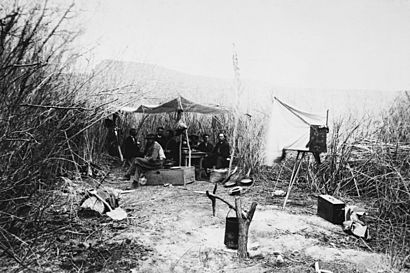Powell Geographic Expedition of 1869 facts for kids
The Powell Geographic Expedition of 1869 was an amazing journey led by John Wesley Powell, an American explorer and scientist. This trip was the first time anyone had fully mapped and studied long parts of the Green and Colorado rivers in the southwestern United States. It was also the first time white men were recorded traveling through the entire Grand Canyon.
The expedition lasted about three months during the summer of 1869. It started from Green River Station in Wyoming Territory and traveled downstream. The explorers went through parts of what are now Colorado and Utah. They finally reached where the Colorado and Virgin rivers meet, in today's Arizona and Nevada. Even with many problems, like losing boats and supplies, and some close calls with drowning, the team created the first detailed descriptions of the canyon lands of the Colorado Plateau. Much of this area had never been explored before.
Powell later went on a second expedition in 1871–72, following some of the same route. In 1875, he wrote a famous book about the first expedition, called Report on the Exploration of the Colorado River of the West and Its Tributaries. He updated and re-released it in 1895 as The Exploration of the Colorado River and Its Canyons.
The Amazing River Journey
Starting the Adventure
Early in their trip on the Green River, the Powell Expedition lost one of their large boats, the No Name. It was lost at a fast part of the river they called Disaster Falls. Luckily, no one was hurt, but they lost many important supplies. This included all their barometers. Barometers are tools that measure air pressure, which helps you figure out how high you are above sea level. Knowing the altitude was very important for Powell to make good maps. It also helped him guess how much further they had to drop before reaching their final destination, which had a known height.
Powell and his team named many places and rock formations along the Green and Colorado rivers. Some of these names include the Flaming Gorge, the Gates of Lodore (in what is now Dinosaur National Monument), and Glen Canyon.
Who Finished the Trip?
Ten men started the journey from Green River Station, but only six finished the whole trip. Frank Goodman left the expedition on July 6. He said he had enough adventure! He walked away and lived for some years with the Paiutes in eastern Utah. He later settled in Vernal, Utah, where he got married and had a family.
The other three adventurers who left the expedition had a tougher time. On August 28, just two days before the trip was supposed to end, Oramel Howland, his brother Seneca, and Bill Dunn left the group. They were worried they couldn't survive the river's dangers much longer. They hiked out of the canyon and were never seen again. Historians still wonder what happened to them. Some believe they might have been killed by local Shivwits Native Americans who mistook them for someone else. Another idea is that they were killed by Mormons who thought they were spies. On August 30, Powell and the five remaining men safely reached the Mormon settlement of St. Thomas, near the mouth of the Virgin River.
Stories and Movies
The expedition has been shown in movies and plays.
- The 1960 Disney movie Ten Who Dared tells their story.
- The 2015 play Men on Boats by Jaclyn Backhaus is also about the expedition.
- The graphic novel "Major Impossible" by Nathan Hale also shares the story of this amazing journey.


